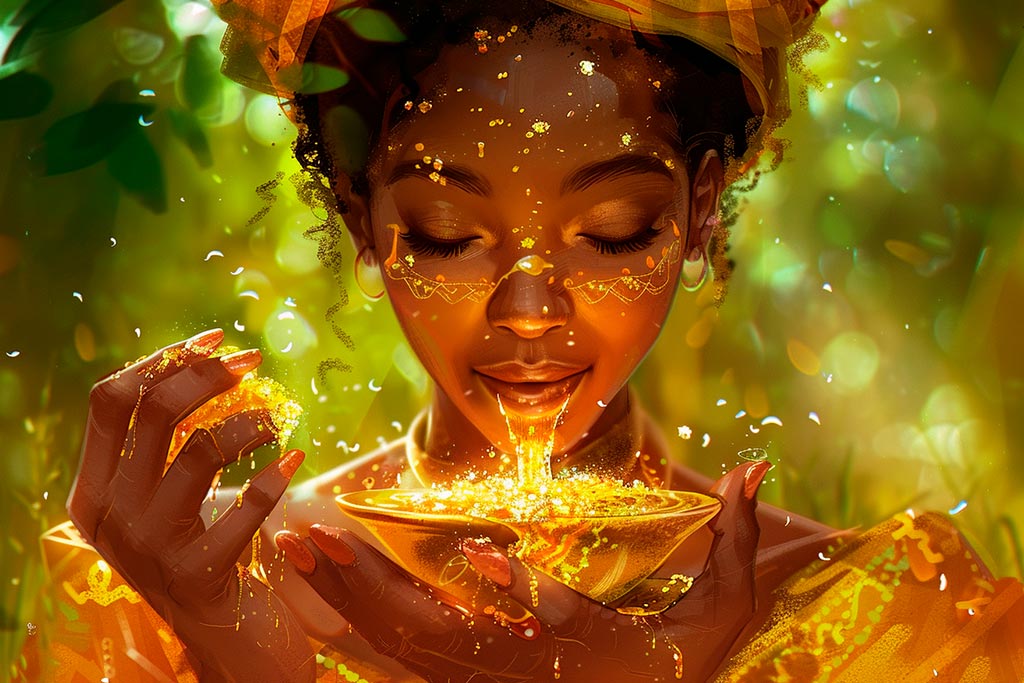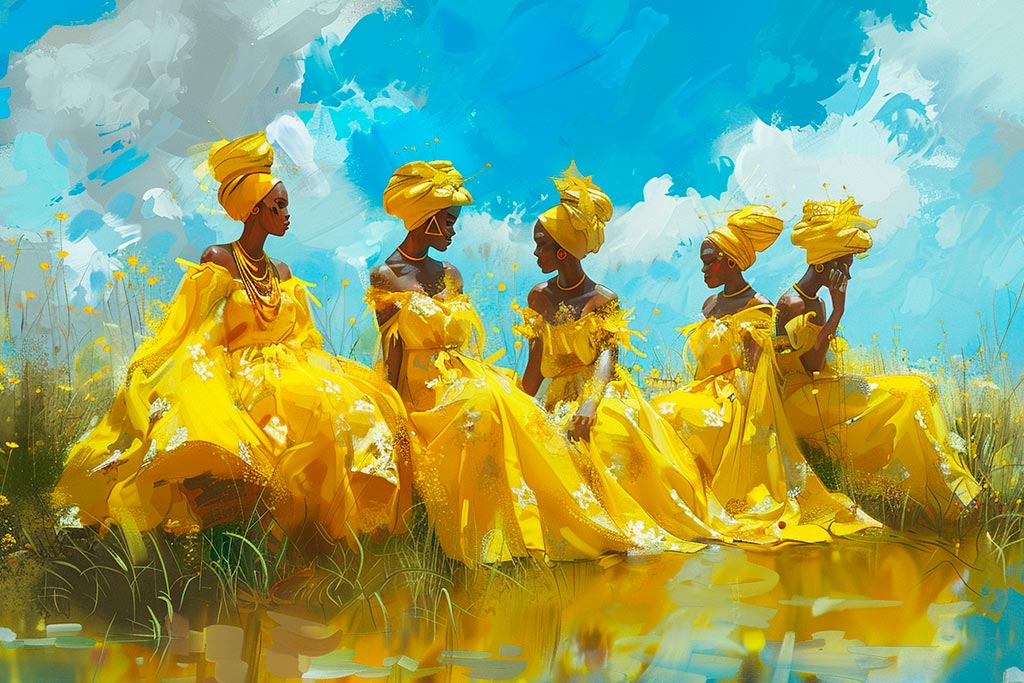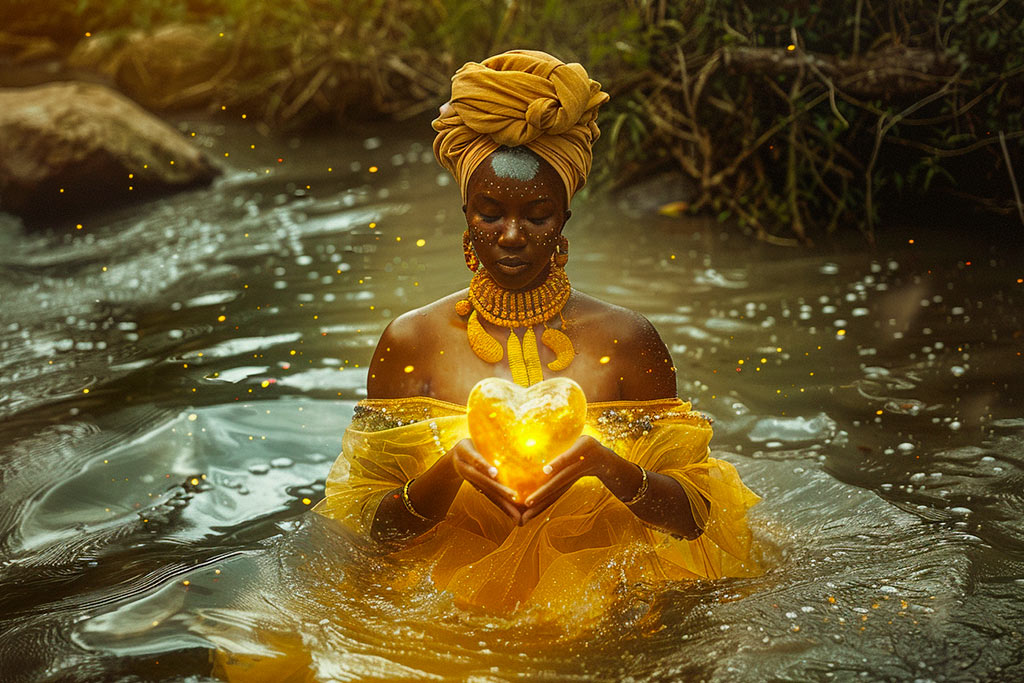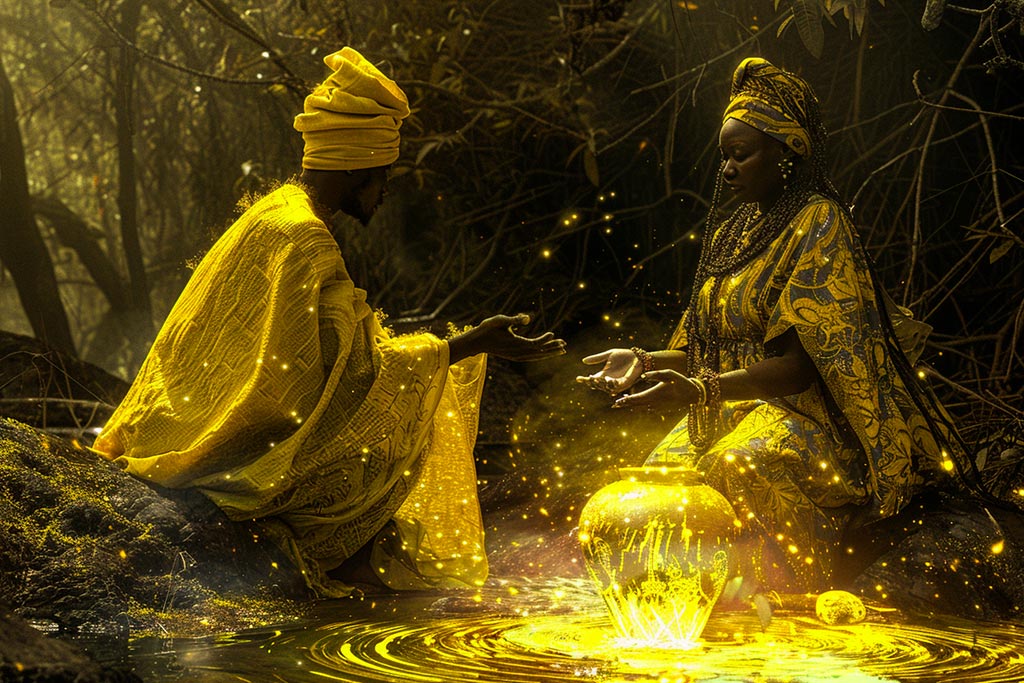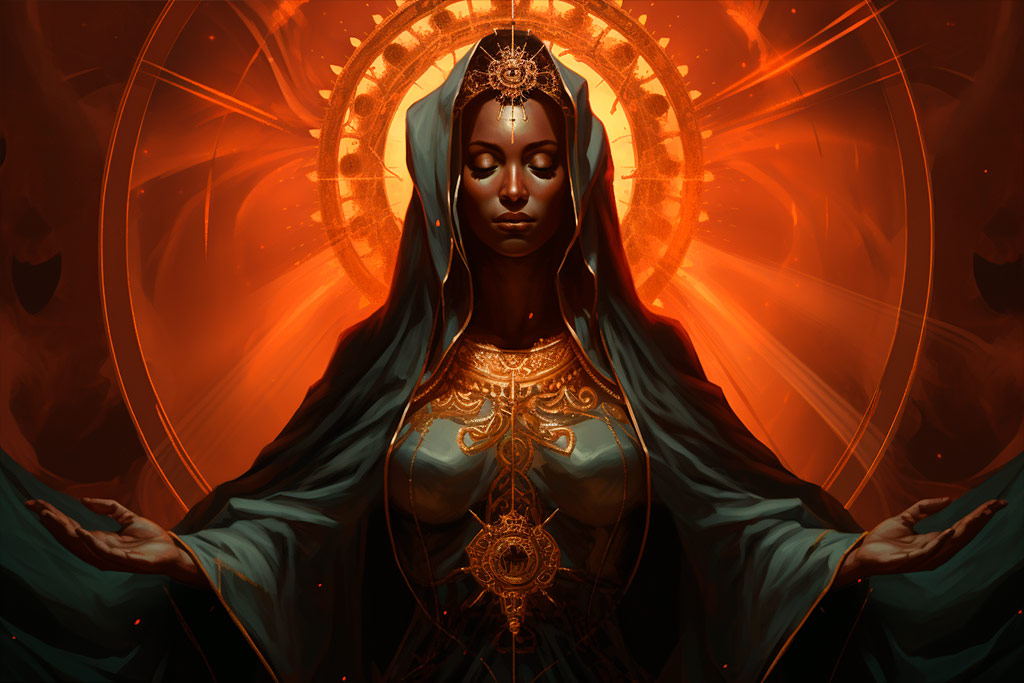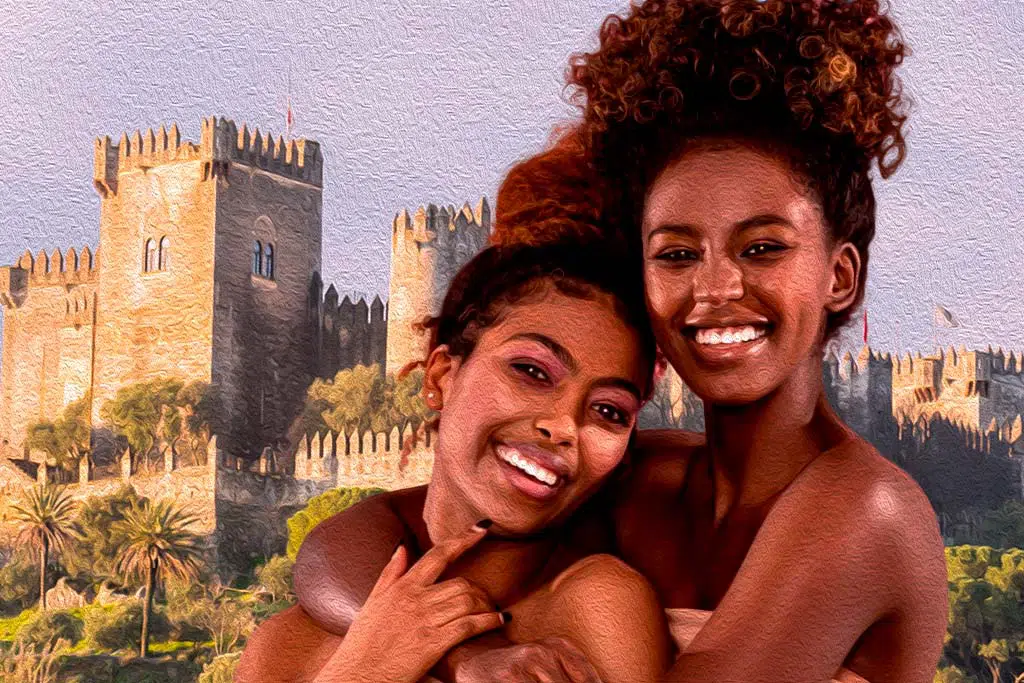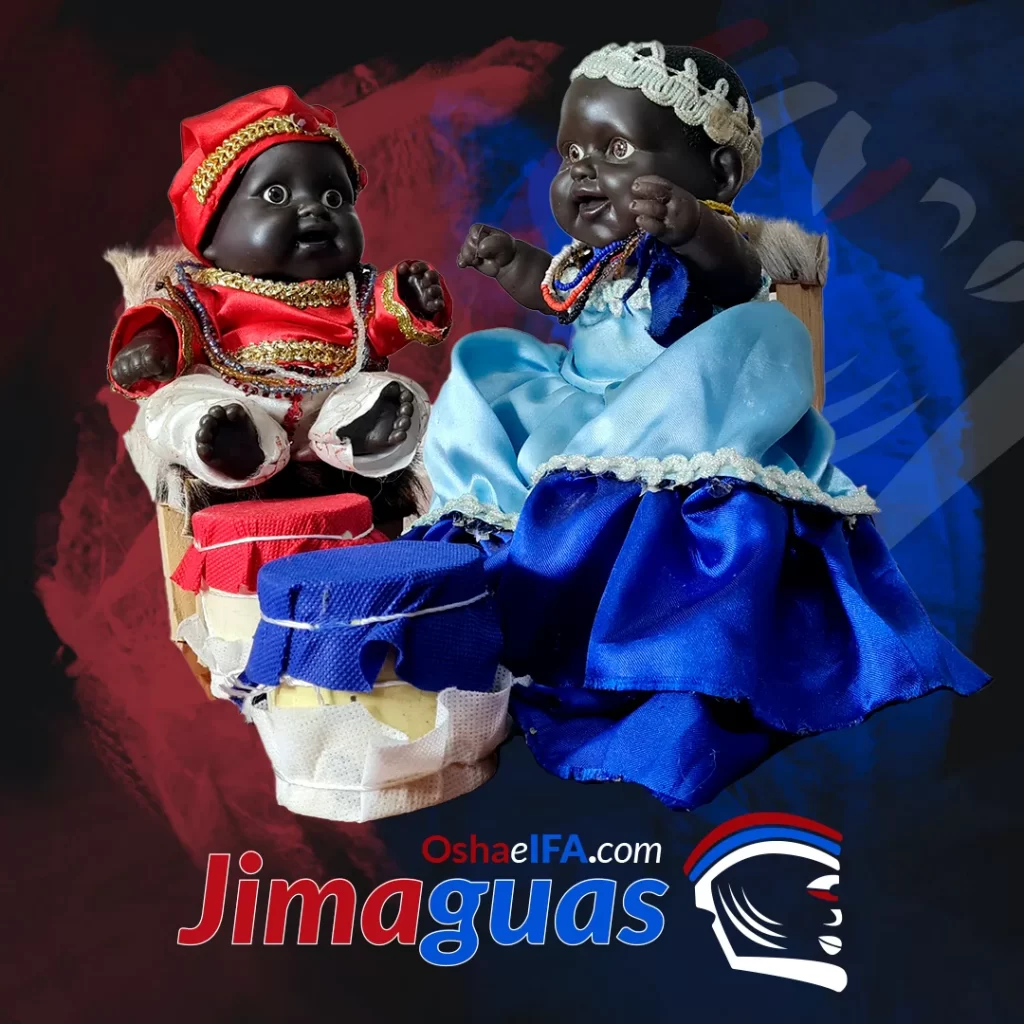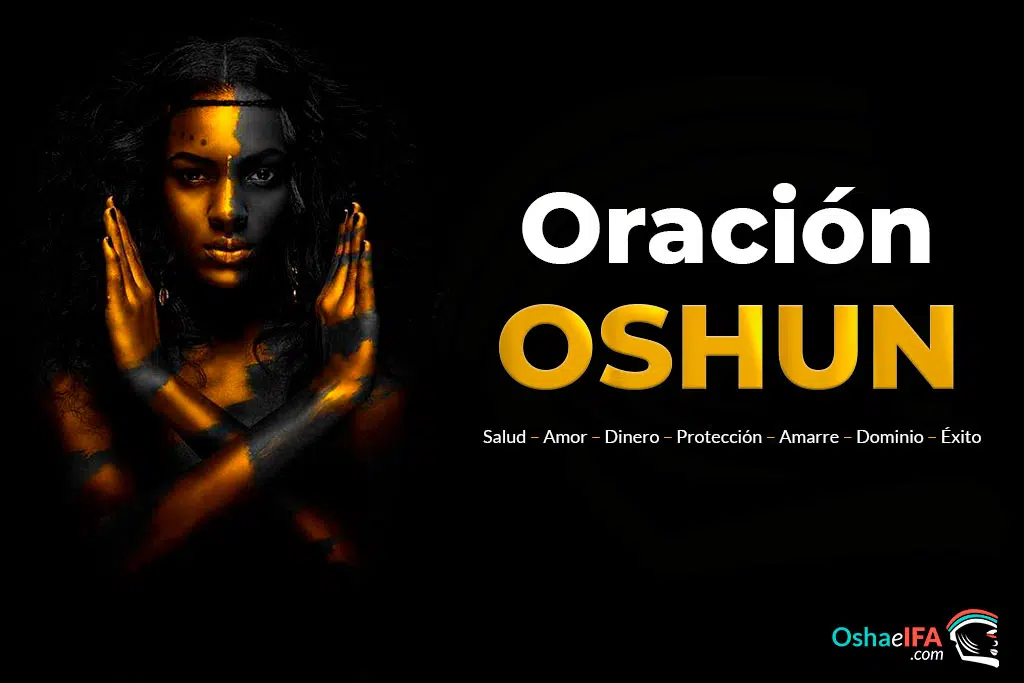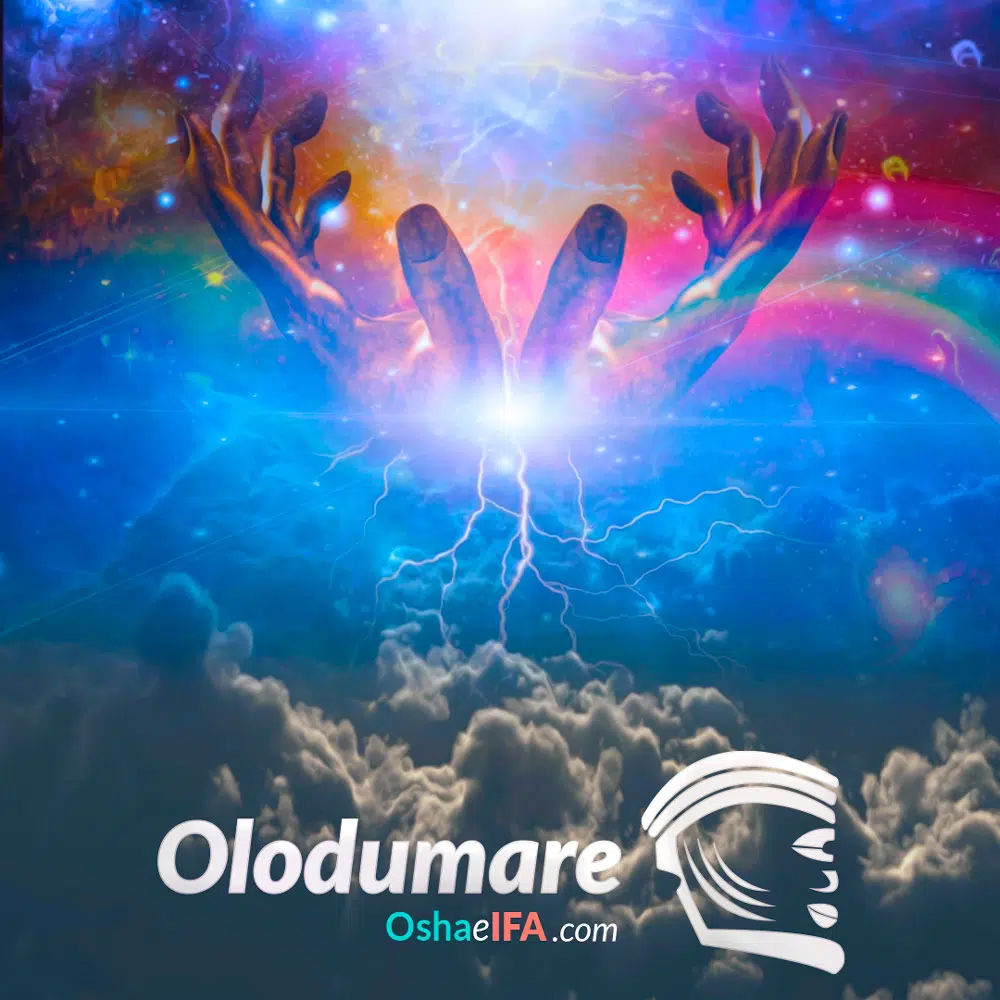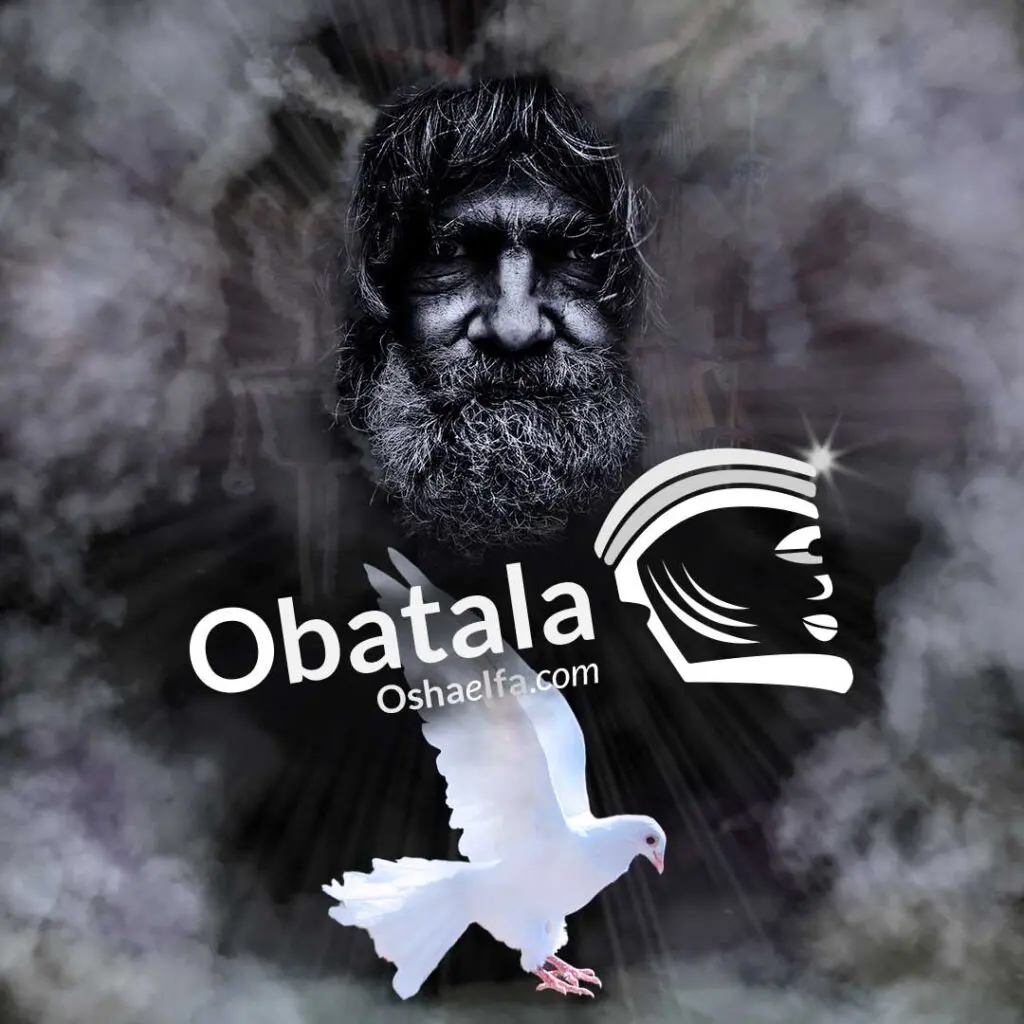Oshun: Orisha of Love, River and Honey

Oshun (Òşun), Orisha venerated in southwestern Nigeria by the Yoruba people, embodies the quintessence of divine femininity. This maternal deity, synonymous with water, purity, fertility, love and sensuality, plays an essential role in the lives and beliefs of its devotees. Considered one of the most powerful goddesses, she possesses human attributes such as vanity, jealousy and anger, which complement her divine nature. Her influence extends beyond the tangible, affecting the spiritual and emotional well-being of those who worship her.
Who is Oshun?
Oshun stands out in Yoruba cosmology for his link with water and fertility, as well as for his role in universal balance and harmony. His story reflects a profound influence, being essential to the creation of humanity and life on Earth. She was sent by Olodumare, to populate and vivify the world. Using her waters, she revitalized the world, guaranteeing human existence and that of other species.
Its transcendence goes beyond creation, encompassing the perpetuation of life and the cycle of birth, life and death. As a fertility deity, her role is crucial in this cycle, evidencing the Yoruba belief in the interdependence of all forms of life. The feminine influence, personified in Oshun, is seen as vital to the continuity of life, highlighting her status as protector of women and patron of pregnancy and childbirth.

Oshun, known for her omniscience, acts as a guardian of ethics and morals. She has the power to punish those who offend her or harm her protection, standing out as a powerful warrior and sorceress. Her ability to be both a giver of life and a bearer of justice underscores the complexity of her figure.
It is central to practices of divination and sacrifice, key rituals for maintaining global balance and harmony. Through these, she seeks her intercession to overcome challenges, reaffirming her role as mediator between the divine and the human.
In short, this orisha is an entity of power, beauty and protection, whose worship remains essential in various communities, especially in Nigeria and throughout the Yoruba diaspora in Latin America, where Santeria has adopted and adapted its teachings and practices. Her legacy inspires those seeking harmony with the natural environment and spiritual well-being, ensuring her position as one of the most revered deities within this rich religious tradition.
Other names by which this Orisha is known
In addition to being widely recognized as Oshun (Òşun), this deity is known by various names that reflect its multiple aspects and the veneration it inspires:
- IYALDE., a title that highlights her position as the "Queen Mother."
- Yeye Kari or Yeye Moro, translated as the "little mother", reflecting her cheerful but arrogant nature.
- Iyami Aje, a term that highlights her power as an ancestral mother with significant magical attributes.
- Osún Dodowa, specific name in the Iyesá region.
- Eninare, which means "she who was put in the path of goodness", used in Nigeria to refer to her benevolence.
- Awoyemi or Omoyumi Naki, names by which she is called in the city of Ife, Nigeria, highlighting her role as a benevolent mother and source of life.
- Oore Yeye, which translates as “the benevolent mother,” emphasizing her generosity and maternal care.
- Sèègèsí, embodiment of grace and beauty.
- Olóòyá iyun, the preeminent hair braider with the comb adorned with coral beads)
These names not only reflect the richness of veneration towards Oshun but also the depth of its meaning within the Yoruba religion, underscoring its importance in various facets of life and the cosmos.
Oshun: Between Sacred Waters and Transatlantic Syncretisms
Oshun connects Yorubaland in Nigeria with the African diaspora in Latin America, symbolizing fertility, beauty, and protection. Revered on the Òşogbo River, her cult is celebrated with rituals that honor life and nature. In Latin America, Oshun transforms into Ochún and Oxum, adapting to the local traditions of Santería and Candomblé.
Òşun in Nigeria: Roots and Reverence in Yorubaland
In Nigeria, the veneration of Òşun is manifested with deep respect and devotion, particularly in the city of Òşogbo, located in the southwest of the country. This place is the spiritual heart of his cult, where the river that bears his name flows, considered a sacred spring and source of life and purification. She is revered as a powerful embodiment of the divine feminine, known for her ability to bestow fertility, love and prosperity. Her protective role over women and children underscores her importance in the Yoruba worldview, linking her influence to the well-being of the community through ritual practices and festivities.
The Òşun Òşogbo Festival: A Meeting Point between the Divine and the Human
The annual Òşun Òşogbo Festival is a vibrant expression of faith and culture that attracts thousands of worshipers and tourists. Through rituals, dances and offerings, participants honor Òşun, seeking his blessing and protection. This festival not only reinforces the spiritual bond with the deity but also promotes community unity, highlighting the role of the deity as the source of life and guardian of Òşogbo.
The Protector of Òşogbo
The history of Òşun is closely linked to the development and protection of Òşogbo, especially during the Fulani Wars of the 19th century, where it is credited with safeguarding and ensuring the survival of its inhabitants. Her divination abilities and her close connection to the natural world, symbolized by her river, highlight her role as a mediator between the earthly and the divine, emphasizing the importance of natural balance and harmony within the community.
Divination and Healing: The Gifts of Òşun
Oshun is a master in the art of divination and medicinal practices, using her knowledge of herbs and the Ifá oracle to heal and protect. Her ability to intercede in matters of fertility and general well-being underscores her position as a central figure in the spiritual and everyday lives of her devotees. Through divination, this orisha guides and offers solutions to the community's problems, reaffirming her role as protector and provider.
The Sanctuary of Òshun
The shrine dedicated to Òşun in Òşogbo is a place of great spiritual power. The attributes that adorn the image of him, such as the large wooden eyes and ears, symbolize his omnipresence and ability to hear the supplications of his followers. Elements such as his sword and metallic insignia reflect his warlike nature and his willingness to defend those devoted to him. The offerings of jewelry, shells, river stones and other natural elements are testimonies of his connection with water and the earth, emphasizing his role as a source of life and healing.
Ochún and Oxum: Manifestations of the river goddess in the African Diaspora of Latin America
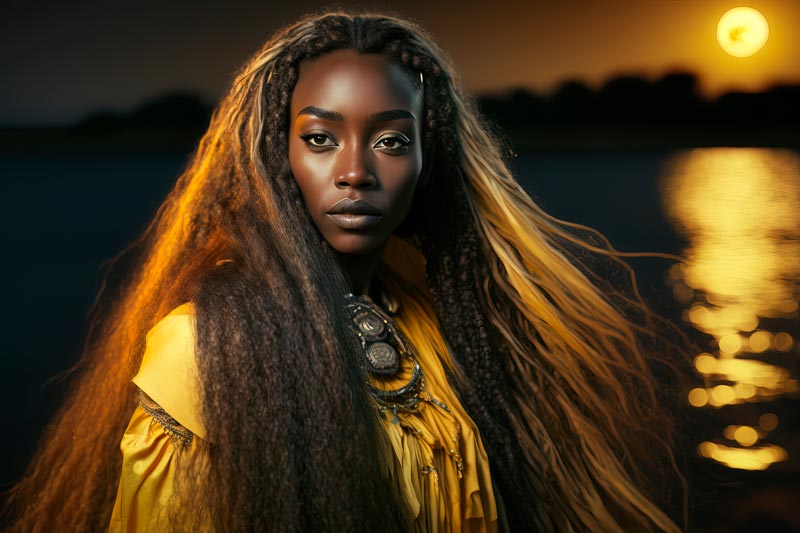
In the African diaspora of Latin America, veneration of Oshun has been intertwined with the local traditions of Santería in Cuba and Candomblé in Brazil, reflecting a rich fusion between Yoruba beliefs and the cultural elements of each region. Known as Ochún in Cuba and Oxum in Brazil, this goddess preserves her dominion over love, fertility, and fresh waters, while she adapts to the particularities of her cult in new contexts.
Adaptations and Syncretisms
In Cuba, Ochún is syncretized with the Virgin of Charity of Cobre, patron saint of the island, symbolizing the resilience and adaptability of the Yoruba faith in the face of colonial oppression. This orisha is invoked for her maternal protection, her power in matters of the heart and for her ability to ensure prosperity. Her devotees offer her mirrors, jewelry, and honey, emphasizing her connection to beauty and divination.
Oshun in the Catholic religion (La Caridad del Cobre)
Oshún is syncretized with the Virgin of Our Lady of Charity of Copper, also known as Charity of Copper or simply Cachita, the Patroness of Cuba. Located in El Cobre, Santiago de Cuba, her image appeared floating on the waters of Nipe Bay, carrying the inscription: "I am the Virgin of Charity." This discovery by the "three Juanes" marked the beginning of a profound syncretism between the two entities, given Oshún's association with gold and copper, as well as her reputation for being charitable and merciful. The Catholic Church recognizes the Virgin as protector of pregnant women, a characteristic that resonates with the role of Ochún in the Yoruba religion.
Oshún in Brazil
In Brazil, Oshun is celebrated for her essentiality in motherhood and her rule over fresh waters. She is attributed characteristics of care, protection and a deep connection with nature and creation. The cult of Oxum emphasizes rituals involving water, perfumes, and flowers, highlighting her role as a deity of fertility and love.
A Transcendental Cultural Icon
Beyond its religious significance, Òşun/Ochún/Oxum has transcended as a cultural icon in Latin America, influencing art, music, and literature. His figure represents the strength and depth of femininity, spiritual resistance and the importance of memory and cultural identity. Through her syncretism with Catholic figures and her presence in cultural events, Oshun symbolizes the survival of African traditions and her ability to adapt and enrich herself in new environments.
The adaptation of Òşun in Santería and Candomblé reveals not only the resilience of Yoruba religious practices in the face of historical challenges, but also the ability of these traditions to dialogue and merge with the local cultures of Latin America. Worship of the goddess in this region highlights the continuity and transformation of African beliefs, underscoring her vital role in the spirituality and culture of the African diaspora.
Characteristics and Symbols of Òşun: A Mirror of His Divinity
The richness of the attributes associated with Oshun not only reveals her complexity as an orisha but also how she is perceived and venerated in different cultures. These features are windows to her essence, offering devotees ways to connect with her through symbols, colors and rituals.
Colors: Between Opulence and Purity
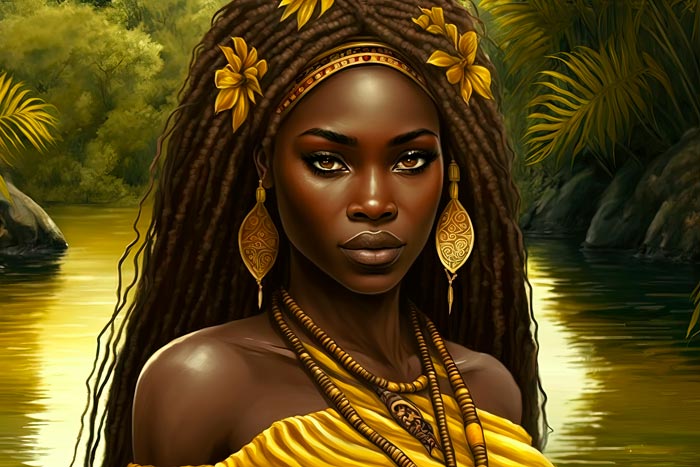
The colors associated with Oshun vary significantly between Cuba and Nigeria, reflecting different facets of his divinity. In Cuba, yellow dominates, evoking joy, intelligence, wealth and opulence — attributes that resonate with Òşun's vibrant personality. This color is often complemented by shades of amber, gold, white, green, red or black, depending on its specific manifestation. On the contrary, in Nigeria, a preference for white is attributed, a color that symbolizes purity and spirituality, underlining a more serene and sacred aspect.
Number: The Fifth Element
The number 5 is sacred to Oshun, symbolizing the fifth element that connects the earthly and spiritual planes. This number reflects change, mutation and the transcendental, aspects intrinsic to the essence of this Orisha as mediator and protector. Through the diloggún (snail), Oshun speaks for the Odu “Oche”, reiterating his link with the number 5 and his role as a source of ancestral wisdom.
Day of Celebration and Dance
September 8, Oshun Day, is celebrated with special fervor in Cuba, marking a point of syncretism with the Virgin of Charity of Cobre. This day, along with every Saturday, highlights the importance of this goddess in the weekly cycle of worship. Her dances, full of beauty and sensuality, capture her essence, using movements that evoke the fluidity of water and the sweetness of honey.
Tureen, Necklaces and Clothing: The Reflection of Its Opulence
The physical elements associated with Oshun, such as the tureen, the necklaces (eleke) and his clothing, are tangible expressions of his divinity. The tureen, especially, can vary in color and design, reflecting the different paths of Oshun and his sometimes capricious nature. The necklaces, made from yellow and amber beads and adorned with other elements depending on your avatar, are symbols of protection and connection. Her clothing, often composed of robes or dresses in colors that reflect her association with gold and sunlight, along with a five-pointed crown, manifests her regality and grace.
Tools: Extensions of Your Power

Oshun's tools, including his golden crown, handcuffs, paddles, golden bell, and more, are manifestations of his abilities as an orisha. These objects not only serve as vehicles for ritual practice but also as reminders of Òşun's vast domains over nature, protection, healing, and divination.
Bridge Between Traditions and Cultures
Comparing Oshun veneration practices in Nigeria and Latin America illustrates a fascinating dynamic of continuity, adaptation, and syncretism. In Nigeria, Òşun is central to the Yoruba worldview, especially in Òşogbo, where his influence is manifested in community protection, fertility and divination. The Òşun Òşogbo Festival is a time of intense spiritual connection, where rituals celebrate life and natural balance. In Latin America, the African diaspora has woven the essence of Òşun into the fabric of Santería and Candomblé, where it is transformed into Ochún and Oxum, respectively. Through syncretism, Oshun merges with Catholic figures such as the Virgen de la Caridad del Cobre, showing the resistance and adaptability of these spiritual traditions in the face of oppression and cultural change.
Both manifestations emphasize the importance of Òşun in the spiritual and community sphere, although the methods and expressions of devotion vary. In Nigeria, Òşun maintains a direct link to his Yoruba origins, preserving ancient traditions and rituals. In Latin America, the cult of Òşun absorbs and reflects local influences, creating a religious practice that is both a preservation of the Yoruba faith and a unique expression of Latin American cultures. This demonstrates not only the flexibility and resilience of Yoruba religious practices but also their ability to provide a sense of identity and belonging in diverse cultural contexts.
You can read: Children of Oshun: What are they like? Description and Features
The Mythological Origin of Oshun (Òșún): From Exclusion to Reverence
Within the Yoruba pantheon, Oshun is distinguished by her story of resilience, wisdom and intrinsic feminine power. Her story, told through the Odù of Ifá, narrates her transition from being initially underestimated by her male counterparts to becoming an essential figure for the order of the world.
A Great Woman among Divinities
At the beginning of time, Olódùmarè entrusted the òrìsà, including Ògún, Sàngó, and Òrúnmìlà, with the task of ordering the world. Among them was Oshun, the only female figure, whose presence was initially ignored in key meetings. However, her exclusion would soon reveal her indispensable contribution to cosmic balance.
Òșún's omission from the deliberations caused their collective efforts to fail, leading the òrìsàs to realize their mistake after consulting with Olódùmarè. It was only after recognizing the importance of Òșhún and requesting his participation and blessing that they were able to successfully advance their divine mission.
Upon their return, the òrìsà apologized to Oshun and made sacrifices to appease her, thus recognizing her vital role not only in the creation but in the maintenance of world order. Oshun demanded, and was granted, equality in participation in all rituals and deliberations, reaffirming her position as a deity of power equivalent to that of her male counterparts.
This episode in Yoruba mythology highlights the importance of inclusion and balance between masculine and feminine principles in maintaining universal order. Oshun, from her initially marginalized position to being recognized as indispensable, symbolizes the strength and necessity of the feminine principle in cosmic harmony.
The Legend of the Settlement of Òṣogbo
The story begins with Olútímíyìn of Òyó and Èlàáróyì of Ìpólé, who are recognized as co-founders of Òṣogbo. Olútímíyìn, a hunter, discovers the Òṣun River and, knowing the drought in Ìpólé, informs Láàróyè about this discovery, leading his people to settle there.
The presence of Òṣun was already there when they decided to settle near the river. While attempting to cut down a large tree within the grove, it was knocked down into the river, and a voice was heard from the water expressing Òṣun's displeasure at the disturbance, prompting the settlers to move towards where the market and the palace. This event marks the beginning of their veneration of Oshun, who would later request that they move away from the banks of the river to allow "his children" (the plant and animal life of the area, and possibly references to a previously established Aboriginal population) to play freely. . This interaction establishes a treaty between the founders and Òṣun, highlighting her role as ruler and protector of the area.
Furthermore, it is narrated how the ruler of Òṣogbo, by making offerings and sacrifices to Òṣun, confirms the blessing of the river waters, which are then used for ritual and medicinal purposes. It is especially significant for women seeking conception, evidencing the spiritual empowerment that this deity grants through its waters.
The Power of Fertility
The Yoruba worldview places fertility at the heart of their culture and spiritual practices, considering it the essence and purpose of existence. This appreciation is embodied in Òșhún, which narrates the intrinsic importance of motherhood and life. Although shown as an entity of wealth and power, he faces the test of infertility, a situation that highlights how procreation transcends status or material possession in the Yoruba hierarchy of values.
Her journey, detailed in the Ifá odù, leads her to seek solutions through divination and sacrifices, emphasizing the vital role of these rituals in obtaining personal and collective desires. By overcoming her infertility challenge and assisting other women in similar situations, Ochun not only reaffirms her divinity but also becomes a symbol of hope and role model for Yoruba women, celebrating fertility as an ideal. supreme.
This story highlights fertility as a reflection of àse—the creative power of the universe—with the absence of offspring seen as a depletion of this essential life force. Yoruba society, therefore, values procreation over material accumulation, considering Oshun, through his ability to bestow life, a central figure in maintaining generational continuity and the immortality of his cult.
Furthermore, this story of Oshun offers a cosmological perspective in which, although Òrìsà-nlá shapes the human form and Olódùmarè breathes life, it is Òșún who, through her womb, introduces this living form to the world. This action not only embodies the cycle of birth and protection against vulnerabilities inherent to existence but also establishes a deep connection with other women who share the sacred duty of motherhood. As a female deity, Oshun holds the unique power to activate humanity, underscoring the impotence of the masculine principle without the complementarity of the feminine. This power highlights the interdependence between genders, affirming the importance of balance and reciprocity in the fabric of Yoruba life and spirituality.
Oshun's Relationship with Other Orishas
In the vast and colorful landscape of the Yoruba religion, each orisha carries a unique sphere of influence, shaping diverse aspects of the natural world and human affairs. Within this complex network of deities, Oshun occupies a special place, not only for his dominions over water, fertility and love, but also for his intricate relationships with other orishas. These interactions weave a fabric of stories and lessons that reflect the interdependence of the forces of nature and the ethical and spiritual principles that guide humanity.
Oshun's relationship with other orishas goes beyond mere coexistence, entering the realm of the symbolic and the functional, where their links reveal the balance necessary for the maintenance of the cosmos and Yoruba society. Through his connections with orishas such as Orula, Shango, Yemaya, among others, Oshun exemplifies the harmony between the different aspects of existence, from the most earthly to the divine.
Orula's Apetebi
The union of Òșhún with Òrúnmìlà stands as a monument to the balance and interdependence of divine forces. This marriage not only highlights the complementarity between deep knowledge and control of spiritual and material elements, but also highlights the importance of sacrifice as a means of accessing and pacifying universal energies. Òșún's willingness to accept and support these sacrifices reflects his essential role in mediating and manifesting divine will on the earthly plane.
The interaction between these two deities, transcending their marital bond, illustrates a fundamental symbiosis between the feminine and masculine dynamics of the cosmos, pointing to the imperative of balance and harmony in sustaining heavenly and earthly order. The synergy of influence emphasizes the reciprocity intrinsic to the act of knowing and mastering esoteric knowledge, reiterating the relevance of offerings and sacrifices within the Yoruba tradition.
This link is a vivid reflection of the interaction between various deities, demonstrating how their roles and responsibilities intertwine and complement each other to facilitate the harmonious flow of life. In this context, the union of Òșhún and Òrúnmìlà becomes a powerful emblem of the cooperation necessary for the promotion and protection of existence in all its aspects.
Patakie:
In Òṣogbo, a land blessed by rivers and crops, a legend of Oshun and Òrúnmìlà is woven. During an exploration with Èṣù, Oshun discovers Eyigbo Meko Nile, a fertile domain under the care of Òrúnmìlà, guardian of the Ifa oracle. Motivated to meet the leader of such prosperous lands, Òșún heads towards him.
Òrúnmìlà, who had just made the sacrifices of the Osa Rosa sign, did not know how his destiny would intertwine with the Yalode. The welcome towards Òșún and Èṣù marks the beginning of a transformative bond. Moved by Òrúnmìlà's wisdom and generosity, Oshun chooses to remain by her side, becoming her apetebí (her wife).
Over time, their union strengthens, evidencing a deep synergy. A crucial challenge examines Oshun's loyalty to Òrúnmìlà when a fire, instigated by Èṣù at Shango's request, threatens his ties. Faced with danger, Yemaya protects her children, while Oshun chooses to safeguard Òrúnmìlà.
Orula, then, declares her as her apetebi for her selfless love and Yemaya, for her unbreakable motherhood, as mother of all. This story not only highlights the roles of these deities in Yoruba mythology but also elevates Oshun as an emblem of love, fertility and protection.
Pataki: Oshun managed to get Oggun out of Monte
Oggun was overwhelmed by the incessant work and the use of his strength. Exhausted, he took refuge in the mountains, abandoning his obligations. The crisis worsened when his father became seriously ill. Desperate, his family sought out Orunmila, who declared Oggun's return vital.
Despite the efforts, Oggun refused to leave the mountain. Then, Oshun, took the initiative. Covered in honey, she entered the forest and sang, attracting Oggun with the sweetness of his voice and the promise of a life reborn:
"Ogun Arere ile bombo lokua, Ogun wa nile, Ogun wa lona ile bombo lokua aye."
Oshun's presence and song, full of hope and tenderness, motivated Oggun to follow her, marking the end of his isolation and the beginning of a new balance.
Oshun's cunning and empathy not only rescued Oggun from his voluntary exile but also restored harmony, proving that love and understanding have the power to transform and heal. This legend highlights Oshun's vital role in Yoruba cosmology: more than a deity of fertility and love, he is an essential force for balance and cohesion. The collaboration between Oshun and Oggun underlines the importance of mutual support and harmonious interaction between the orishas to maintain the order and stability of the cosmos.
The Discord between Oshun and Shango
Akere was a town immersed in misery, Oshun decided to act in the face of the hardship of its inhabitants, offering help and spiritual consecrations to improve their lives. This, however, angered Shango, orisha of thunder, who, due to previous grievances, wished to keep Akere in misery. Shango began to destroy Oshun's work, killing those she had blessed.
The conflict escalated until it reached Olofin, the divine authority, who intervened to end the hostility. Olofin ruled that, to preserve peace, Oshun and Shango must refrain from consecrating each other's followers, thus ensuring mutual respect and human well-being.
This incident highlights the need for conflict resolution and balance within Yoruba cosmology, showing how disputes between deities can deeply affect humans. Olofin's decision emphasizes the importance of mutual respect and cooperation, not only between orishas but as an essential principle for communal and universal harmony.
I sing to the Orisha Oshun
You can read: Prayer to Oshun: Invocations for Money, Love and Protection
Frequently asked questions about this Orisha
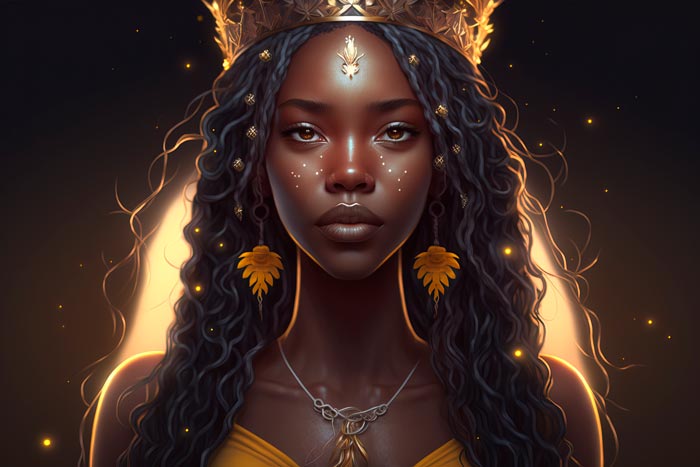
In what sign did Oshun come down to earth? odu isalaye
Oshún arrives in the earthly world accompanied by the Odu of Ifa «Oshe Tura». During this trip she comes with Eshu Agbire. The Odu Oche Turá tells that Oshun comes down to earth to fulfill a mission directly imposed by Oloddumare in which he is entrusted with preserving harmony among humans, making it clear to them that the love that must be kept alive among all the creatures that make up existence and the universe.
Is it true that Oshun does not forgive?
Oshun is an Orisha whose nature is very delicate. She has no tolerance for disobedience to her advice or commands. She is estimated to have great patience, but when the anger of this Orisha annoys her, she has no comparison with any other saint of the Yoruba pantheon. When it comes to punishing her, Oshun rebukes human beings through diseases in their genitals or in the blood.
Oshun's laugh
When Oshún's elegun (her holy horses) go into a trance and are possessed by their spirituality, they laugh as Yemayá does. However, Oshun's laughter causes great concern in all his devotees, since it is believed that when he laughs it is a bad omen, it may be announcing that something bad is going to happen or it is when he is most upset. On the contrary, if she arrives crying, she is warning that situations will come that will cause great joy.
You can read: Oshun works for love
Oshun Quotes

Oshun says: "Try to enjoy my honey because you will never like to taste my bile."
Oshun says: "Keep my blessing today and always, do not forget that I do not accept betrayal and when I get upset I never forgive."
